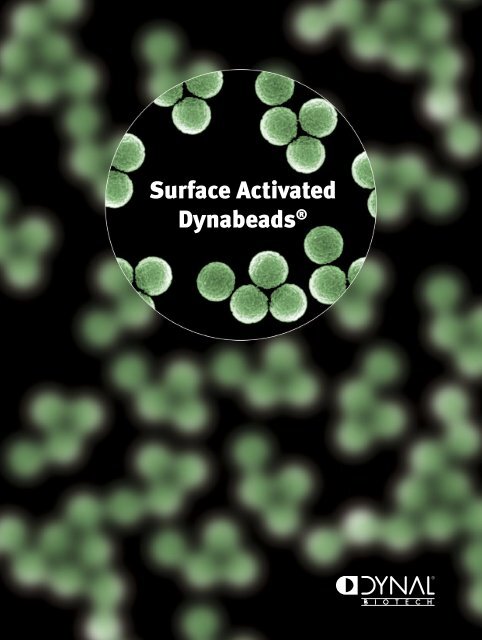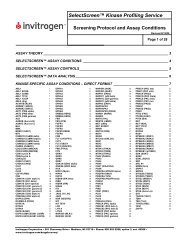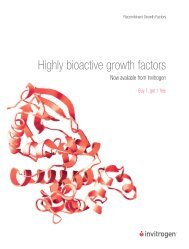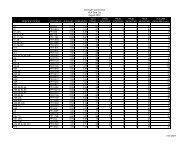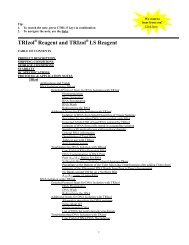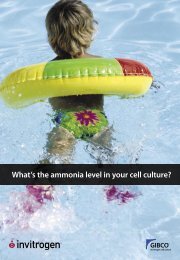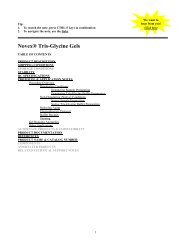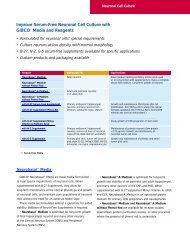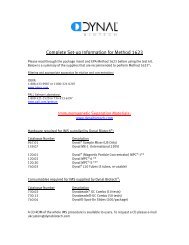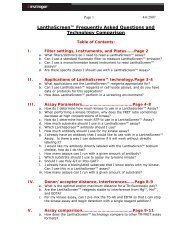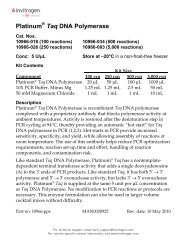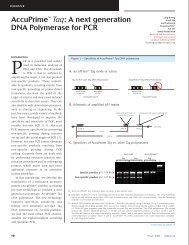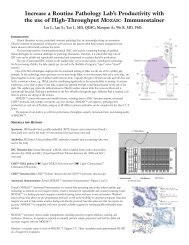Surface Activated Dynabeads.indd - Invitrogen
Surface Activated Dynabeads.indd - Invitrogen
Surface Activated Dynabeads.indd - Invitrogen
You also want an ePaper? Increase the reach of your titles
YUMPU automatically turns print PDFs into web optimized ePapers that Google loves.
<strong>Surface</strong> <strong>Activated</strong><br />
<strong>Dynabeads</strong> ®<br />
www.dynalbiotech.com
•<br />
•<br />
•<br />
A variety of ways to bind your ligand<br />
Manual or automated handling<br />
Protein separation technology<br />
Introduction<br />
<strong>Dynabeads</strong> ® are superparamagnetic monosized polymer<br />
spheres. They are magnetic only when placed in a magnetic<br />
field, with no magnetic remanence when the magnetic field<br />
is removed. <strong>Dynabeads</strong> ® are composed of highly cross-linked<br />
polystyrene with magnetic material precipitated in evenly<br />
distributed pores. The ferrous compound is sealed inside the<br />
bead by an additional layer of polymer. Chemical groups are<br />
then introduced onto the bead surface to facilitate binding<br />
of almost any ligand, and subsequent easy and convenient<br />
isolation of the bound target (fig. 1).<br />
Unique Monodispersity<br />
The unique monodispersity and uniformity<br />
of the <strong>Dynabeads</strong> ® provide optimal and<br />
reproducible reaction kinetics, and a rapid<br />
and efficient binding of target molecules.<br />
<strong>Dynabeads</strong> ® are easily dispersed and<br />
handle almost like a liquid. In addition,<br />
chemical agglutination and nonspecific<br />
binding are negligible as<br />
compared with irregularly shaped<br />
particles.<br />
Hydrophobic or<br />
Hydrophilic<br />
Dynal Biotech provides surface<br />
activated <strong>Dynabeads</strong> ® with<br />
both hydrophobic and hydrophilic<br />
characteristics:<br />
The hydrophilic beads allow<br />
for gentle coupling of ligands<br />
to the surface. The functional<br />
ac tivit y of enz y mes and<br />
labile proteins is therefore<br />
intact after immobilisation.<br />
T he hydrophilic proper ties<br />
of the beads ensure optimal<br />
dispersion in suspension. Very<br />
low nonspecific binding of proteins,<br />
dyes etc. is observed with the pH<br />
neutral M-270 Epoxy beads, thus<br />
the requirement for blocking agents<br />
is reduced. The functional groups of<br />
the M-270 Amine and Carboxylic Acid<br />
beads allow further introduction of a large<br />
variety of alternative reactive groups by using<br />
commercially available cross-linkers.<br />
Fig. 1 Principle of biomagnetic<br />
separation with <strong>Dynabeads</strong> ® .<br />
<strong>Surface</strong> <strong>Activated</strong> <strong>Dynabeads</strong> ®<br />
2<br />
•<br />
•<br />
•<br />
Superior reproducibility<br />
All-in-one-tube protocols<br />
Easy handling and no sample loss<br />
A hydrophobic surface is an excellent choice for coupling of<br />
antibodies for affinity purification of organelles or proteins.<br />
The hydrophobic Fc region of the antibody is adsorbed to the<br />
hydrophobic bead surface, followed by a rapid covalent bond<br />
formation. The orientation of the antibody is optimal, with the<br />
Fab regions facing outwards. The resultant yield of target protein<br />
or organelle fractionation is elevated.<br />
Small or Large, Automation or Manual Handling<br />
Dynal Biotech offers surface activated <strong>Dynabeads</strong> ® of various<br />
sizes. For work with proteins, nucleic acids or similar materials,<br />
we recommend the 1.0 µm (the MyOne TM series) or the 2.8 µm<br />
(the M-280 and M-270 series). The larger 4.5 µm beads are well<br />
suited to isolating larger entities such as organelles or cells.<br />
Due to their size and high iron content they exert a strong pull<br />
to the magnet, even in viscous samples, yet still retain gentle<br />
handling of the bound target. The <strong>Dynabeads</strong> ® are easy to<br />
handle manually using simple magnet racks for the isolation<br />
of target.<br />
<strong>Dynabeads</strong> ® MyOne TM are ideal for isolation of smaller entities<br />
such as proteins and bacteriophages. In addition, the 1.0<br />
µm beads have a large surface area, high capacity, efficient<br />
magnetic pull and excellent properties for automation. The<br />
MyOne TM products are tailor-made for use in automated<br />
protocols where high throughput is crucial. Dynal Biotech<br />
has developed suitable protocols for several of the robotic<br />
workstations available on the market.<br />
Specific Considerations<br />
To obtain the best possible result, it is important to choose the<br />
correct product for your specific application. The table on page<br />
5 will help you decide which product to use. The choice will first<br />
of all depend on the nature of the ligand.<br />
A successful coupling of a ligand to tosylactivated beads<br />
requires primary amino- or sulphydryl groups. The orientation<br />
of the active site of the ligand must also be taken into<br />
consideration. Hydrophobic beads facilitate interactions<br />
between the beads and the hydrophobic parts of the proteins,<br />
whereas the hydrophilic beads are suitable when interactions<br />
between the beads and the hydrophilic parts of the proteins<br />
are desired. If the ligand is a labile peptide or protein, the best<br />
choice is to use beads with epoxy groups allowing for coupling<br />
down to 4°C. Carboxylic acid beads, with which peptide bonds<br />
are formed within minutes, are a satisfactory alternative.<br />
www.dynalbiotech.com
Ligand Target<br />
Antibody Protein or<br />
antibody<br />
Antibody<br />
fragment<br />
Low MW<br />
antigen 1<br />
or peptide<br />
<strong>Dynabeads</strong> ®<br />
Tosylactivated<br />
<strong>Dynabeads</strong> ®<br />
Carboxylic<br />
Acid<br />
<strong>Dynabeads</strong> ®<br />
Amine<br />
<strong>Dynabeads</strong> ®<br />
Epoxy<br />
√ √ √ √ √ √ √<br />
√ √ √ √ √ √ √ √ √<br />
<strong>Dynabeads</strong> ®<br />
Subcellular<br />
Organelles √ √ √ √ 2 √ √ √<br />
Bacteria √ √ √<br />
Virus √ √ √ √ √ √ √ √ √<br />
Phage 1 √ √ √ √ √ √ √ √ √<br />
Phage 1 or<br />
antibody<br />
Protein Phage 1 or<br />
carbohydrate<br />
Peptide Phage 1 or<br />
antibody<br />
√ √ √ √ √ √ √ √ √ √<br />
√ √ √ √ √ √ √ √ √<br />
Nucleic acid √ √ √ √ √ √<br />
√ √ √ √ √ √ √ √ √ √<br />
Carbohydrate Antibody √ √ √ √ √<br />
Low MV antigen Antibody √ √ √ √ √ √ √ √<br />
Nucleic acids,<br />
oligonucleotide,<br />
aptamer, PNA<br />
Nucleic acid<br />
binding<br />
proteins 1<br />
DNA 1 , RNA 1 or<br />
PCR amplicants 1<br />
Enzyme Substrate<br />
or target<br />
for enzyme<br />
degradation<br />
Organic<br />
chemistry<br />
derivatisation,<br />
including<br />
introduction of<br />
new functional<br />
groups<br />
1 <strong>Dynabeads</strong> ® Streptavidin may be the best product choice<br />
2 <strong>Dynabeads</strong> ® M-450 Epoxy<br />
√ √ √ best product choice for listed ligand and target<br />
√ √ alternative choice for listed ligand and target<br />
√ can be used for listed ligand and target<br />
√<br />
√ √ √<br />
√ √ √ √ √ √ √<br />
√ √ √ √ √ √ √ √<br />
5<br />
www.dynalbiotech.com
<strong>Surface</strong> <strong>Activated</strong> <strong>Dynabeads</strong> ® : <strong>Dynabeads</strong> ® M-500<br />
Subcellular<br />
Bead Characteristics: • Slightly hydrophobic bead.<br />
•<br />
•<br />
<strong>Surface</strong> tosyl groups.<br />
Bead diameter 4.5 µm.<br />
Binding Properties: • Direct covalent binding to<br />
primary amino- or sulphydryl<br />
groups in proteins and<br />
peptides.<br />
No further surface<br />
activation required.<br />
Binding overnight at neutral<br />
to high pH and 37 o C.<br />
Main Benefits: • Five layers of epoxy coating<br />
ensures a super-smooth bead<br />
surface, perfect for<br />
EM-visualisation of captured<br />
organelles.<br />
Applications and<br />
Reaction Chemistries:<br />
•<br />
•<br />
•<br />
•<br />
•<br />
The Fc portion is generally<br />
more hydrophobic than<br />
the Fab regions, facilitating<br />
biologically active orientation<br />
of your antibody.<br />
Organelle fractionation.<br />
EM pictures of organelles.<br />
3<br />
<strong>Dynabeads</strong> ® M-280<br />
Tosylactivated<br />
•<br />
•<br />
•<br />
•<br />
•<br />
•<br />
•<br />
•<br />
•<br />
•<br />
•<br />
Hydrophobic bead.<br />
<strong>Surface</strong> tosyl groups.<br />
Bead diameter 2.8 µm.<br />
Direct covalent binding to<br />
primary amino- or sulphydryl<br />
groups in proteins and<br />
peptides.<br />
No further surface<br />
activation required.<br />
Binding overnight at neutral<br />
to high pH and 37 o C.<br />
High capacity for isolating<br />
proteins by using an<br />
immobilised antibody.<br />
The Fc portion is generally<br />
more hydrophobic than<br />
the Fab regions, facilitating<br />
biologically active orientation<br />
of your antibody.<br />
Protein purification.<br />
Isolation of fragile cells<br />
(the smaller beads are<br />
pulled gently to the magnet,<br />
ensuring the isolation of<br />
intact and viable cells).<br />
IVD<br />
<strong>Dynabeads</strong> ® MyOne TM<br />
Tosylactivated<br />
•<br />
•<br />
•<br />
•<br />
•<br />
•<br />
•<br />
•<br />
•<br />
•<br />
•<br />
Hydrophobic bead.<br />
<strong>Surface</strong> tosyl groups.<br />
Bead diameter 1.0 µm.<br />
Direct covalent binding to<br />
primary amino- or sulphydryl<br />
groups in proteins and<br />
peptides.<br />
No further surface<br />
activation required.<br />
Binding overnight at neutral<br />
to high pH and 37 o C.<br />
High capacity for isolating<br />
proteins by using an<br />
immobilised antibody.<br />
The Fc portion is generally<br />
more hydrophobic than<br />
the Fab regions, facilitating<br />
biologically active orientation<br />
of your antibody.<br />
Protein purification.<br />
Isolation of rare cells (rapid<br />
kinetics due to high number<br />
of beads).<br />
IVD<br />
www.dynalbiotech.com
<strong>Dynabeads</strong> ® M-270<br />
Amine<br />
•<br />
•<br />
•<br />
•<br />
•<br />
•<br />
•<br />
•<br />
•<br />
•<br />
•<br />
Hydrophilic bead.<br />
<strong>Surface</strong> amino groups.<br />
Bead diameter 2.8 µm.<br />
Direct covalent binding<br />
through reductive amination<br />
of aldehydes.<br />
No further surface<br />
activation required.<br />
Rapid binding (less than 1<br />
hour) at neutral to high pH<br />
and room temperature.<br />
Rapid immobilisation of<br />
carbohydrates, glycoproteins<br />
and glycolipids<br />
(e.g. lipopolysaccharides).<br />
Easy introduction of<br />
further alternative surface<br />
chemistries.<br />
Isolation of cells, proteins<br />
or other target molecules<br />
with affinity for specific<br />
carbohydrate moieties.<br />
These beads can be used<br />
to introduce other reactive<br />
groups by coupling different<br />
cross-linking reagents.<br />
C-terminal coupling of<br />
peptides.<br />
<strong>Dynabeads</strong> ® M-270<br />
Carboxylic Acid<br />
•<br />
•<br />
•<br />
•<br />
•<br />
•<br />
•<br />
•<br />
•<br />
•<br />
•<br />
•<br />
Hydrophilic bead.<br />
<strong>Surface</strong> carboxylic acid<br />
groups.<br />
Bead diameter 2.8 µm.<br />
Covalent amide bond<br />
formation with primary<br />
amino- and sulphydryl groups<br />
in proteins and peptides.<br />
Activation through<br />
carbodiimide is required.<br />
Immediate peptide bond<br />
formation at pH 5-6 and<br />
room temperature.<br />
100% covalent binding.<br />
Low non-specific binding of<br />
nucleic acids.<br />
Rapid binding chemistry.<br />
Immobilisation of labile<br />
proteins and peptides.<br />
N-terminal coupling of<br />
peptides.<br />
IVD<br />
<strong>Dynabeads</strong> ® MyOne TM<br />
Carboxylic Acid<br />
•<br />
•<br />
•<br />
•<br />
•<br />
•<br />
•<br />
•<br />
•<br />
•<br />
•<br />
•<br />
•<br />
Hydrophilic bead.<br />
<strong>Surface</strong> carboxylic acid<br />
groups.<br />
Bead diameter 1.0 µm.<br />
Covalent amide bond<br />
formation with primary<br />
amino- and sulphydryl groups<br />
in proteins and peptides.<br />
Activation through<br />
carbodiimide is required.<br />
Immediate peptide bond<br />
formation at pH 5-6 and<br />
room temperature.<br />
100% covalent binding.<br />
Low non-specific binding of<br />
nucleic acids.<br />
Rapid binding chemistry.<br />
Immobilisation of labile<br />
proteins and peptides.<br />
N-terminal coupling of<br />
peptides.<br />
IVD<br />
NA IVD<br />
4<br />
<strong>Dynabeads</strong> ® M-270<br />
Epoxy<br />
•<br />
•<br />
•<br />
•<br />
•<br />
•<br />
•<br />
•<br />
•<br />
•<br />
Hydrophilic bead.<br />
<strong>Surface</strong> epoxy groups.<br />
Bead diameter 2.8 µm.<br />
Direct covalent binding to<br />
primary amino and<br />
sulphydryl functional groups<br />
in proteins and peptides.<br />
No further surface<br />
activation required.<br />
Binding overnight at neutral<br />
pH, high salt and a wide<br />
temperature range.<br />
The functionality of your<br />
enzyme is maintained<br />
after isolation.<br />
Very low non-specific<br />
binding of proteins is<br />
observed with these<br />
pH neutral beads.<br />
Purification of temperaturelabile<br />
proteins and active<br />
proteins such as enzymes.<br />
Immobilisation of protein<br />
A and G.<br />
Analysis of enzymatic<br />
reactions by coupling the<br />
enzyme directly onto the<br />
beads.<br />
www.dynalbiotech.com
Ordering Information<br />
Product Concentration Volume Product No.<br />
<strong>Dynabeads</strong> ® M-270 Amine<br />
Hydrophilic beads with amino groups.<br />
<strong>Dynabeads</strong> ® M-450 Epoxy<br />
Hydrophobic beads with epoxy goups.<br />
<strong>Dynabeads</strong> ® M-270 Epoxy<br />
Hydrophilic beads with epoxy goups.<br />
<strong>Dynabeads</strong> ® M-450 Tosylactivated<br />
Hydrophobic beads with tosyl group.<br />
<strong>Dynabeads</strong> ® M-280 Tosylactivated<br />
Hydrophobic beads with tosyl group.<br />
<strong>Dynabeads</strong> ® MyOne Tosylactivated<br />
Hydrophobic beads with tosyl group.<br />
<strong>Dynabeads</strong> ® M-270 Carboxylic Acid<br />
Hydrophilic beads with carboxylic acid groups.<br />
<strong>Dynabeads</strong> ® MyOne Carboxylic Acid<br />
Hydrophilic beads with carboxylic acid groups.<br />
<strong>Dynabeads</strong> ® M-500 Subcellular<br />
Slightly hydrophobic beads with tosyl groups.<br />
© Copyright 2005 Dynal Biotech ASA, Norway. Printed 02.05. All rights reserved.<br />
Dynal ® , <strong>Dynabeads</strong> ® and Dynal MPC ® are registered trademarks of Dynal Biotech ASA.<br />
The <strong>Dynabeads</strong> ® products are covered by several international patents and patent applications.<br />
Dynal Biotech is an ISO 9001 certified company.<br />
30 mg/ml<br />
Dynal Biotech will not be responsible for violations or patent infringements that may occur with the use of our products.<br />
Dynal Biotech ASA, Norway, tel: + 47 22 06 10 00<br />
Dynal Biotech LLC, USA, tel: + 1 800 558 4511<br />
Dynal Biotech GmbH, Germany, tel: + 49 40 36 15 73 23<br />
Dynal Biotech Ltd, UK, tel: + 0 800 731 9037<br />
Dynal Biotech S.A, France, tel: + 33 3 44 23 45 95<br />
Dynal Biotech Pty Ltd, Australia, tel: + 1 800 623 453<br />
Dynal Biotech Beijing Ltd, tel: + 86 10 67 80 67 08<br />
Nihon Dynal K.K., Japan, tel: + 81 3 35 93 78 61 www.dynalbiotech.com<br />
www.dynalbiotech.com<br />
MOL.B.017.01<br />
2 ml<br />
10 ml<br />
143.07<br />
143.08<br />
30 mg/ml 5 ml 140.11<br />
60 mg<br />
300 mg<br />
freeze-dried<br />
freeze-dried<br />
143.01<br />
143.02<br />
30 mg/ml 10 ml 302.12<br />
30 mg/ml<br />
30 mg/ml<br />
100 mg/ml<br />
100 mg/ml<br />
30 mg/ml<br />
10 mg/ml<br />
2 ml<br />
10 ml<br />
10 ml<br />
2 ml<br />
10 ml<br />
2 ml<br />
10 ml<br />
2 ml<br />
10 ml<br />
100 ml<br />
142.03<br />
142.04<br />
301.01<br />
655.01<br />
655.02<br />
143.05<br />
143.06<br />
650.11<br />
650.12<br />
650.13<br />
30 mg/ml 2 ml 150.01<br />
Dynal MPC ® -S Unit 120.20<br />
Dynal MPC ® -96S Unit 120.27<br />
<strong>Dynabeads</strong> ® products for cell separation and other applications are available at www.dynalbiotech.com.<br />
If you need assistance in choosing the right product please contact our Technical Centre.


